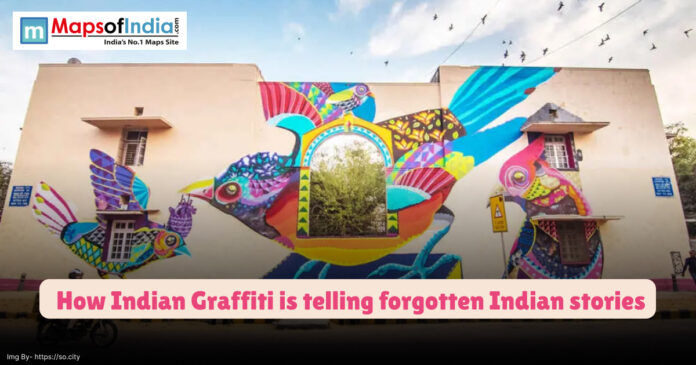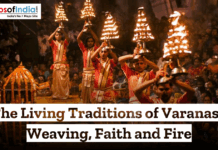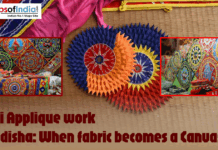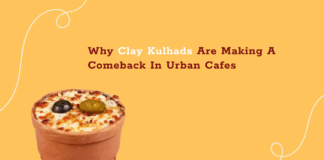Graffiti is a widely known art form in the world. In most parts of the world, this is associated with spray painting on the wall. But in India, it is more than that. This art form uses a vibrant canvas to tell forgotten stories. We can see from ancient caves to modern streets that there is some kind of graffiti. This tells about culture, resistance, and identity. Nowadays, artists are using graffiti to revive overlooked histories. Artists are honouring unsung heroes and are also highlighting social issues. Cities like Mumbai, Delhi, and Kochi pulse with these visual tales.
Ancient Roots of Indian Graffiti
The art form of Graffiti is not new to India. This art form dates back thousands of years. The Bhimbetka caves in Madhya Pradesh contain wall paintings which date back 30000 years. The paintings on these walls show hunting scenes and rituals. In a recent expedition in Tamil Nadu, archaeologists have found graffiti at Keeladi resembling Indus Valley symbols. Arrows, fish, and swastikas are linked across cultures. Ancient mural caves in Ajanta caves show Buddhist stories. Many Tribal communities paint mud huts with many vibrant designs. These are the early forms of public expressions. These arts told stories of faith, survival, and community. Nowadays, new artists draw graffiti from this heritage. These artists use walls to share their viewpoint just as their ancestors did.
From Vandalism to Cultural Voice
In the 1990s, the art form of graffiti was seen as an act of vandalism. Many Cities like Bombay and Delhi were painted all over. After the 1992 Mumbai riots, walls in Colaba became canvases for protest art. People Anonymous raised their voice in anger and hope. By 2006, artists like Daku and Yantra shifted perceptions. These artists painted socio-political messages on the walls of Delhi and Mumbai. According to a recent study, graffiti has risen as a mainstream art form. Festivals like St+Art India founded by Hanif Kureshi helped to legitimise this art form. Murals now brighten neighbourhoods. Artists like Kartikey Sharma create works that spark wonder. Graffiti has evolved from the art of rebellion to the art of storytelling. This art has also given a voice to marginalised histories.
Reviving Unsung Heroes
The art form of graffiti in India is used to honour forgotten historical figures. In Mumbai’s Mahim, the location of Charanjiva’s murals depicts women’s wisdom. Her 2022 piece “Don’t Mess With Me” celebrates resilience. Leena Kejriwal’s “MISSING” project uses black silhouettes to show human trafficking. These stark images seen in many parts of Kolkata and Delhi are telling the stories of lost girls. In Chennai at Kannagi Nagar resettlement these graffiti honour local communities. According to a report, artists’ paintings are used to unite residents. Graffiti has also revived many historical figures. The artwork of freedom fighters like Birsa Munda appears in many parts of Jharkhand. These works help to keep their legacies alive. They remind passersby of overlooked contributions.
Addressing Social and Political Issues
Graffiti in many areas of the world addresses many tough topics. In 2008, Daku’s Devanagari script graffiti in Delhi talked about corruption. His ITO piece showed a blindfolded protester which symbolised societal neglect. Ghoradia’s “Breaking the Silence” project in Mumbai uses Bollywood imagery to address gender inequality. Her 2022 artwork highlights domestic violence and stereotyping. In 2020, Chennai artists painted Thanos with masks to promote awareness of COVID-19. Political graffiti is the main topic of graffiti in many parts of the world. In Kolkata, a 2004 Reuters image shows anti-Vajpayee slogans. These graffiti made dialogue possible. Graffiti helps to bring forgotten topics to public spaces. Artists risk backlash to deliver the truth. Many graffiti demand attention to injustice.
Cultural Fusion in Urban Spaces
The art of graffiti in India has a blend of local and global in its styles. In Kochi, Guess Who’s 2014 graffiti mixed Western pop culture with Indian icons. His Banksy inspired stencils of Bob Marley and Che Guevara adorn Fort Kochi. Zine, the famous artist from Mizoram, uses neon colours and geometric shapes to make his graffiti stand out. His Delhi works reflect Mizo heritage. According to a report, Mumbai’s Bandra is developing as a graffiti hub. There are many graffiti which fuse cartoon characters with traditional motifs giving it a new vibe. In Goa, Fontain has lanes have many vibrant arts which have ties with its local history. These works tell stories of cultural exchange happening over the ages. This graffiti is connecting India’s past with its modern identity. Global festivals like Street of Styles in Brazil have featured many Indian artists. This fusion amplifies forgotten narratives.
Empowering Communities Through Art
Graffiti has transformed many neighbourhoods. Mumbai’s Sassoon Dock Art Project which is backed by St+Art India helped to revitalise a fishing community. Graffiti there tells stories of their local life. Delhi’s Lodhi Colony known as India’s first art district has over 50 artists painting walls. This wall has vibrant and thoughtful artworks. Chennai’s Kannagi Nagar became a public art destination in 2021. These graffiti projects have their own pride. They involve locals through workshops. A Khirki Extension’s festival has local b-boys. Art has become a shared language between communities. Graffiti heals forgotten spaces. Communities reclaim their stories through these colourful graffiti on walls.
Challenges and the Path Forward
The art form of Graffiti and its artists have faced many obstacles over time. Many cities around the world still view this art form as an act of vandalism. According to a BBC report on artist GuessWho, there are legal risks. Artists often draw Provocative art which can lead to trouble with authorities. Artists like Daku avoid taking permission which risks removal of their art. Social media has amplified their reach but also invites trouble. People in India are ok with paan stains but reject graffiti. Funding is another hurdle for this art form. Festivals rely on NGOs. Scaling requires government support. Climate and urban development threaten much of the graffiti. But there is a bright future for this art. More artists are emerging. With training and availability of legal spaces the movement can sustain itself.
Conclusion
The art form of graffiti in India is a powerful form of storytelling. This has helped us know about forgotten histories from Bhimbetka to modern streets. There are many artists like Daku, Guesswho, and Charanjiva who are reviving our unsung heroes. These artists are tackling social issues with bold graffiti. Community led projects can transform neglected spaces in cities. Despite legal and societal challenges there is a chance for graffiti to thrive. This art form is a rebellion, a celebration, and a memory keeper. Each mural tells a story we can’t afford to forget. Supporting artists ensures these voices endure.





